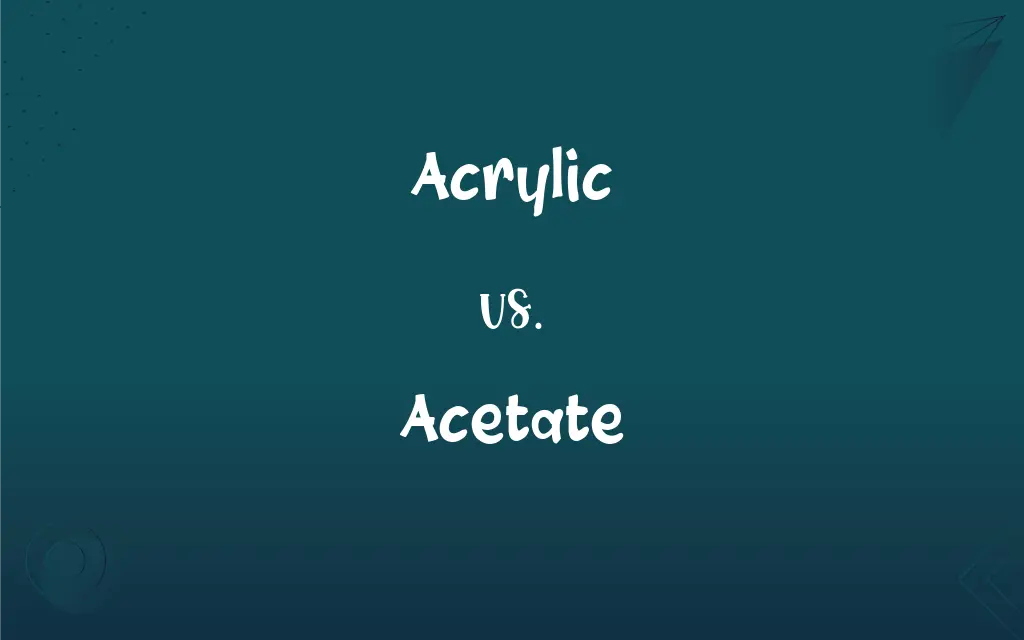Acrylic vs. Acetate: What's the Difference?
Edited by Harlon Moss || By Janet White || Published on December 26, 2023
Acrylic is a synthetic polymer used in paints and plastics, while acetate is a chemical compound used in photography and textiles.

Key Differences
Acrylic refers to synthetic materials made from polymers of acrylic acid, commonly used in paints, fabrics, and plastics. Acetate, on the other hand, is derived from acetic acid and is used in film, textiles, and as a food additive. Both materials are known for their versatility in various industries.
In terms of production, acrylic is manufactured through a process of polymerization, resulting in a durable and resistant material. Acetate, however, is produced by reacting cellulose with acetic anhydride, leading to a material that is known for its silk-like feel in textiles and its clarity in film. Both materials are synthetic but have different production processes and end uses.
Acrylic products are often praised for their strength, clarity, and resistance to weather and chemicals, making them suitable for outdoor applications. Acetate is appreciated for its breathability, luster, and draping quality in textiles, but it's less durable than acrylic. While both materials are used in fashion, they serve different functional and aesthetic purposes.
The environmental impact of both acrylic and acetate is a topic of discussion. Acrylic production involves potent chemicals and can be less biodegradable. Acetate, although derived from natural cellulose, also requires chemical processing, impacting its eco-friendliness. Both materials present challenges and considerations in terms of sustainability.
In terms of applications, acrylic is widely used in arts for paints, in construction for windows and signage, and in fashion for accessories and clothing. Acetate is prominent in the production of photographic film, eyewear, and as a food additive. Both acrylic and acetate have carved niches in diverse industries due to their unique properties.
ADVERTISEMENT
Comparison Chart
Composition
Synthetic polymer from acrylic acid
Chemical compound from acetic acid
Uses
Paints, plastics, fabrics
Photography, textiles, food additive
Production
Polymerization process
Reaction of cellulose with acetic anhydride
Properties
Durable, weather-resistant
Silk-like feel, less durable
Environmental Impact
Less biodegradable, chemical-intensive
Derived from natural cellulose, but requires chemicals
ADVERTISEMENT
Acrylic and Acetate Definitions
Acrylic
In textiles, acrylic is a synthetic fiber known for its wool-like qualities.
Her acrylic sweater was warm, lightweight, and easy to care for.
Acetate
Acetate is a derivative of acetic acid used in making photographic film.
The photographer preferred using acetate film for its fine grain and clarity.
Acrylic
Acrylic refers to a synthetic material made from polymers.
The artist preferred acrylic paints for their vibrant colors and quick drying time.
Acetate
Acetate can be a food additive, often used as a preservative.
The cake's ingredients included acetate to maintain freshness.
Acrylic
Acrylic paints are popular in art for their versatility and water resistance.
He used acrylics to create a painting that had a glossy, polished finish.
Acetate
Acetate is a compound used in various industrial applications.
The laboratory used acetate in several chemical reactions and processes.
Acrylic
Acrylic is used in plastic products for its strength and clarity.
The acrylic windows were durable and provided excellent insulation.
Acetate
In textiles, acetate is known for its silk-like appearance and feel.
Her dress was made of acetate, giving it a luxurious and glossy look.
Acrylic
Acrylic can also refer to items made of acrylic material, like sheets or displays.
The museum used acrylic cases to protect its artifacts.
Acetate
Acetate is used as a plastic in products like eyeglass frames.
He chose acetate frames for his glasses because they were lightweight and stylish.
Acrylic
An acrylic resin.
Acetate
A salt or ester of acetic acid.
Acrylic
A paint containing acrylic resin.
Acetate
Cellulose acetate or any of various products, especially fibers, derived from it.
Acetate
(organic chemistry) Any salt or ester of acetic acid.
Acetate
Cellulose acetate.
Acetate
A transparent sheet used for overlays.
Acetate
Ellipsis of acetate disc: a disc of aluminium covered in a wax used to make demonstration copies of a phonograph record.
Acetate
A salt formed by the union of acetic acid with a base or positive radical; as, acetate of lead, acetate of potash.
Acetate
A salt or ester of acetic acid
Acetate
A fabric made from cellulose acetate fibers
FAQs
How is acrylic made?
Acrylic is made through a polymerization process of acrylic acid derivatives.
Can acrylic be recycled?
Acrylic can be recycled, but the process is complex and not always widely available.
What are common uses of acrylic?
Acrylic is used in art (paints), construction (sheets, windows), and fashion (fibers).
What is acrylic?
Acrylic is a synthetic polymer used in various applications like paints, plastics, and textiles.
What is acetate?
Acetate is a chemical compound derived from acetic acid, used in textiles, photography, and as a food additive.
Can acetate be used in clothing?
Yes, acetate is used in clothing, especially for its silk-like feel and glossy appearance.
Is acrylic environmentally friendly?
Acrylic production involves chemicals and is less biodegradable, raising environmental concerns.
How is acetate produced?
Acetate is produced by reacting cellulose with acetic anhydride.
What are acetate's main uses?
Acetate is used in making photographic film, textiles, eyewear, and as a food additive.
Is acrylic safe for food contact?
Acrylic can be safe for food contact if it's food-grade and properly manufactured.
How does acrylic react to heat?
Acrylic can withstand low to moderate heat but may warp or deform at high temperatures.
Is acetate biodegradable?
Acetate, derived from cellulose, can be more biodegradable than synthetic materials but still requires chemicals for its production.
Can acetate be found in household items?
Yes, acetate is found in household items like photographic film, eyewear, and certain fabrics.
Is acetate a good material for eyewear?
Acetate is popular for eyewear due to its lightweight, stylish, and hypoallergenic properties.
Does acetate shrink or stretch?
Acetate can shrink under heat and does not stretch significantly.
Are acrylic paints water-resistant?
Yes, acrylic paints are water-resistant once they are dry.
Are acrylic products durable?
Acrylic products are known for their durability, strength, and weather resistance.
What is the texture of acetate fabric?
Acetate fabric has a smooth, silk-like texture and glossy appearance.
Can acrylic be used outdoors?
Acrylic is suitable for outdoor use due to its weather-resistant qualities.
Are acrylic fibers comfortable to wear?
Acrylic fibers are lightweight and warm but may not be as breathable as natural fibers.
About Author
Written by
Janet WhiteJanet White has been an esteemed writer and blogger for Difference Wiki. Holding a Master's degree in Science and Medical Journalism from the prestigious Boston University, she has consistently demonstrated her expertise and passion for her field. When she's not immersed in her work, Janet relishes her time exercising, delving into a good book, and cherishing moments with friends and family.
Edited by
Harlon MossHarlon is a seasoned quality moderator and accomplished content writer for Difference Wiki. An alumnus of the prestigious University of California, he earned his degree in Computer Science. Leveraging his academic background, Harlon brings a meticulous and informed perspective to his work, ensuring content accuracy and excellence.








































































